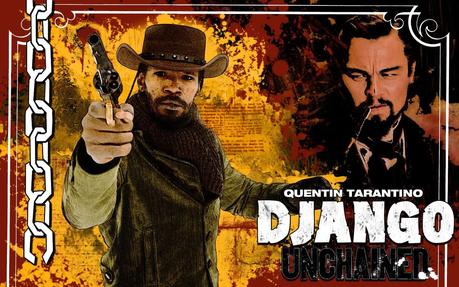
B+
Here’s the thing about Django Unchained, the latest adrenaline-fueled film from genre-savant Quentin Tarantino: it’s a fine time at the movies, as kinetically entertaining and charmingly pulpy as anything its director has done over the past decade. It stars Jamie Foxx as the titular Django, a slave in pre-Civil War America who is purchased by a German bounty hunter named King Schultz (Christoph Waltz). Schultz needs Django’s help in identifying some wanted men who mistreated Django in the past, a gig which becomes a full-time job and eventually, after the pair discover that Django’s wife Broomhilda (Kerry Washington) has been purchased by deadly southern dandy Calvin Candy (Leonardo Dicaprio), a rescue operation. For fans of Tarantino’s work, the rhythms are familiar: there are lengthy dialog sequences where characters are built one idiosyncrasy at a time, followed by bursts of carefully choreographed violence where all the tension is gloriously released. It’s slick, it’s smooth, it’s funny, it’s fun.
It’s also touchy, and weird, and maybe a bit offensive, because Django Unchained isn’t just a stylishly irreverent reworking of the Western, it’s a stylishly irreverent reworking of the Western that happens to be about slavery, a serious subject if there ever was one. Hanging over the film is always this question: should a movie about such an ugly part of American history be this much fun?
It would be different if Django Unchained was just some piece of genre fluff, if it was cheap and looked cheap, if it glossed over the characters and got straight to the violence. But like all Tarantino films, it’s built with too much care to just write off. Take the scene where Schultz, with Django in tow, walks into a dusty western backwater and casually shoots the local lawman, who we shortly learn had a price on his head. While waiting for the fallout, Django and Scultz sit down and share a beer in the local tavern. As they chat, we learn how Scultz feels about the institution of slavery, how Django feels about his potential future as a bounty hunter, and sense the growing respect between the two men, all while the tension over how the townsfolk will respond to the shooting bubbles underneath. It’s a rich scene, and one of many.
The movie reaches its high point after Django and Schultz track down Django’s wife to an opulent cotton plantation. There they meet Stephen (Samuel L. Jackson), a house slave who has so thoroughly absorbed the racist beliefs of his owner that he now forces them upon others. Stephen is a nasty piece of work, the most interesting character in the film, and an excellent showcase for the talents of Samuel L. Jackson. He is also the most problematic character in the movie. The ideas concerning racial self-hatred he embodies are potent, and perhaps best left to a film willing to really take the time to dig into them.
Although Django Unchained is probably the most mature, substantive film Tarantino has made yet, it’s still ultimately a celebration of style, more interested in movies about slavery than in slavery itself. The Stephen character, in particular, is very deftly written. He’s a sycophantic clown when entertaining his master’s guests, an iron-hearted sadist when dealing with those who displease him, and something like an equal when giving private counsel to his owner. There’s a lot of depth to him, but because the movie is in the final estimation a simple revenge tale as pure as Kill Bill before it, those elements aren’t given enough space.
The film climaxes with a thrilling shootout set to anachronistic music and featuring Django as a duel-wielding whirling dervish of revenge. It’s impeccably shot and inventively staged; Tarantino continues to grow as an action director, but at this point is almost too expected, and not entirely worthy of the carefully crafted script. It’s been gratifying to watch Quentin Tarantino inch toward taking himself more seriously film by film, year by year, but Django Unchained is a length of the journey, not journey’s end.
A review by Dan Selcke

